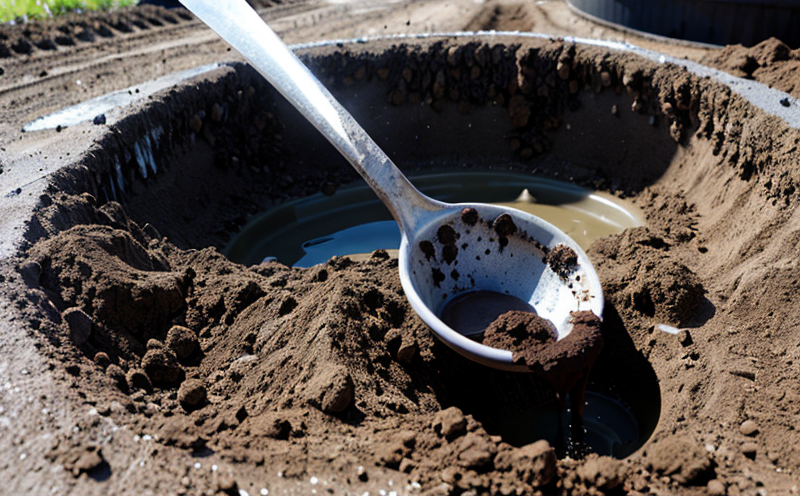EPA 821R02 Whole Effluent Toxicity of Sludge Leachate Test
The EPA 821-R-02 Whole Effluent Toxicity (WET) test is a critical method for assessing the toxicity of sludge leachate, which is an effluent generated from municipal and industrial wastewater treatment systems. Sludge leachate contains various pollutants including heavy metals, organic compounds, nutrients, and pathogens, posing significant risks to aquatic ecosystems if improperly managed or discharged.
The WET test evaluates whether this leachate can cause adverse effects on aquatic organisms through a series of toxicity tests. This is done by measuring the inhibition of growth or survival rates of selected species when exposed to different concentrations of the leachate. The results provide insights into potential risks and guide necessary corrective actions, ensuring compliance with environmental regulations.
The testing procedure involves several steps: first, sludge samples are collected from wastewater treatment plants and prepared according to specified guidelines. These samples are then subjected to rigorous quality checks before being used for toxicity tests. The test organisms commonly used include Daphnia magna (water flea), fathead minnows, or other appropriate species depending on the regulatory requirements.
During the testing phase, leachate dilutions are prepared and exposed to the test organisms in controlled laboratory conditions. Toxicity is determined by observing changes in the organisms' behavior over a defined period, typically 48 hours for Daphnia magna. The EPA standard specifies strict acceptance criteria: the no-effect concentration (NEC) must be less than or equal to 10 mg/L to ensure that the effluent does not pose significant risks.
The results of these tests are crucial for determining whether sludge leachate can be safely discharged into receiving waters without causing harm. Compliance with regulatory requirements is essential, particularly in regions where stringent environmental standards are enforced, such as those governed by the EPA or equivalent national authorities.
This testing method not only helps in assessing immediate risks but also supports long-term planning for sustainable wastewater management. By identifying potential toxic compounds early on, waste management strategies can be optimized to minimize environmental impacts and improve overall ecological health.
- Quality Checks: Rigorous quality checks are performed on sludge samples to ensure accuracy and reliability of the test results.
- Toxicity Testing: Leachate dilutions are tested using selected species of organisms under controlled laboratory conditions.
- No-Effect Concentration (NEC): The NEC value is a critical parameter used to assess the safety threshold for leachate discharge.
Benefits
The EPA 821-R-02 Whole Effluent Toxicity test offers several key benefits, particularly in ensuring environmental compliance and protecting public health. By accurately assessing the toxicity of sludge leachate, this testing method helps facilities avoid costly fines and legal repercussions associated with non-compliance.
For quality managers and compliance officers, regular monitoring ensures that waste management practices are effective and environmentally responsible. It also facilitates timely implementation of corrective measures to address any identified risks. For R&D engineers involved in wastewater treatment processes, this testing provides valuable data for optimizing treatment technologies and improving overall system efficiency.
The test results can inform the development of more sustainable waste management strategies, which not only enhance environmental protection but also contribute positively to corporate social responsibility initiatives. By adhering to rigorous testing protocols, organizations demonstrate their commitment to minimizing ecological impacts and fostering healthier ecosystems.
Eurolab Advantages
At Eurolab, we pride ourselves on offering comprehensive services that meet the highest standards of accuracy, reliability, and precision. Our dedicated team of experts ensures that every test conducted adheres strictly to EPA guidelines and relevant international standards such as ISO 17025.
We utilize state-of-the-art equipment and methodologies tailored specifically for sludge leachate testing, guaranteeing consistent and reproducible results. Our facilities are equipped with advanced laboratories designed to handle a wide range of sample types, ensuring that we can accommodate diverse client needs. This capability allows us to provide timely and accurate reports, which are essential for making informed decisions regarding waste management practices.
Our commitment to excellence is further underscored by our robust quality assurance processes. These include regular calibration of instruments, training of staff, and continuous improvement initiatives aimed at maintaining the highest standards of service delivery. Additionally, we maintain strong relationships with regulatory bodies and industry associations, ensuring that our methodologies remain up-to-date and relevant.
By choosing Eurolab for your sludge leachate testing needs, you can trust in the reliability and accuracy of our services. Our expert team will work closely with you to understand your specific requirements and deliver tailored solutions that meet your unique challenges.
Quality and Reliability Assurance
To ensure the highest level of accuracy and reliability in our testing services, Eurolab adheres to stringent quality control measures. Regular calibration of instruments guarantees that all equipment is operating within specified tolerances. Our staff undergo continuous training to stay updated on the latest methodologies and best practices.
We maintain a robust quality management system that complies with ISO 17025 standards, ensuring consistent and reproducible results. By adhering to these rigorous protocols, we can confidently provide data that is both accurate and trustworthy.





